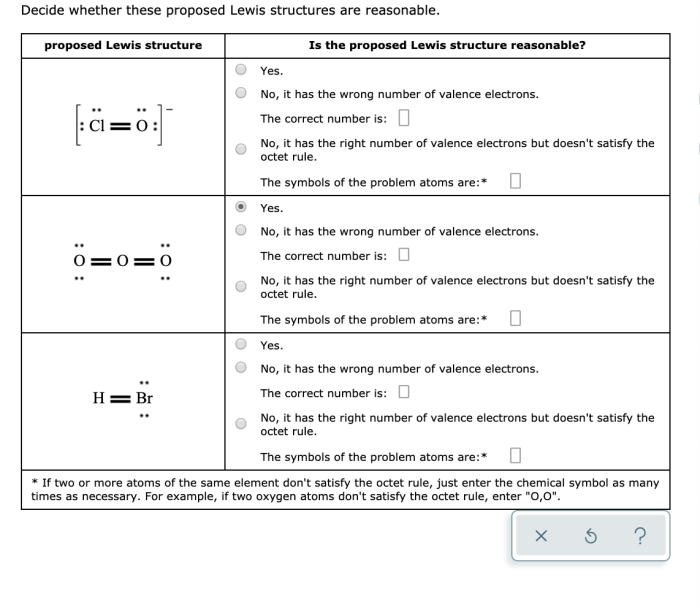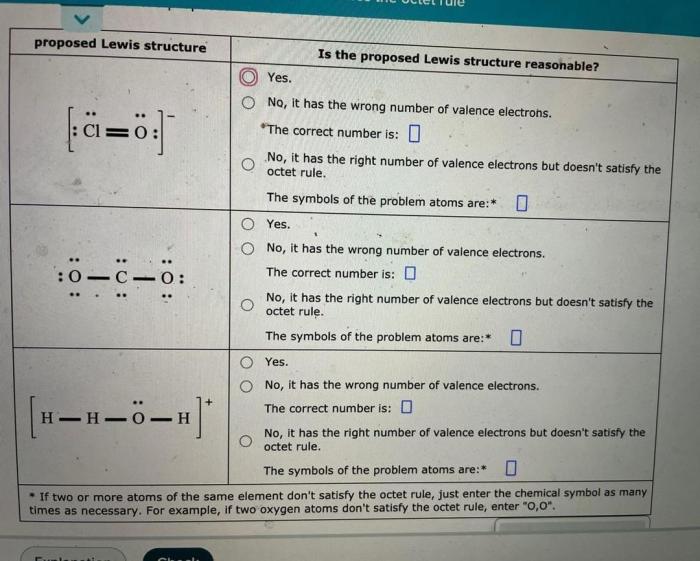Decide whether these proposed lewis structures are reasonable – In the realm of chemistry, the evaluation of proposed Lewis structures holds immense significance. Lewis structures serve as visual representations of molecular structures, depicting the arrangement of atoms and electrons within a molecule. However, not all proposed Lewis structures are equally valid.
This article delves into the meticulous process of determining the reasonableness of proposed Lewis structures, exploring various criteria and considerations that guide chemists in their assessments.
The subsequent paragraphs will delve into the intricacies of formal charge calculations, the adherence to the octet rule, the identification of resonance structures, the analysis of bond lengths and angles, and the comparison with experimental data. Additionally, the article will highlight other factors that may influence the reasonableness of Lewis structures, ensuring a comprehensive understanding of this fundamental aspect of chemical bonding.
Evaluating the Reasonableness of Proposed Lewis Structures

Lewis structures are graphical representations of the electronic structure of molecules. They are used to predict the geometry, bonding, and reactivity of molecules. However, not all proposed Lewis structures are reasonable. There are several criteria that can be used to evaluate the reasonableness of a Lewis structure, including formal charges, the octet rule, resonance structures, bond lengths and angles, and comparison to experimental data.
Identify the Formal Charges of the Atoms
The formal charge of an atom in a Lewis structure is the charge that the atom would have if all of the electrons in the molecule were assigned to the atoms with the lowest electronegativity. Formal charges can be used to identify atoms that are particularly unstable or reactive.
Atoms with large formal charges are more likely to participate in chemical reactions in order to reduce their formal charge.
To calculate the formal charge of an atom, subtract the number of electrons assigned to the atom in the Lewis structure from the number of valence electrons that the atom has in its elemental state. The following equation can be used to calculate the formal charge of an atom:
“`Formal charge = Valence electrons
- Nonbonding electrons
- 1/2 Bonding electrons
“`
For example, the formal charge of the carbon atom in the following Lewis structure is 0:
“`:C(H)(H):“`
The carbon atom has four valence electrons. Two of these electrons are used to form bonds with the hydrogen atoms, and the other two electrons are nonbonding electrons. Therefore, the formal charge of the carbon atom is 4 – 2 – 1/2(2) = 0.
Examine the Octet Rule
The octet rule states that atoms are most stable when they have eight valence electrons. This rule is based on the fact that the noble gases, which are the most stable elements, all have eight valence electrons. The octet rule can be used to identify atoms that are particularly unstable or reactive.
Atoms that do not obey the octet rule are more likely to participate in chemical reactions in order to achieve a more stable electron configuration.
There are some exceptions to the octet rule. For example, hydrogen atoms can only have two valence electrons, and helium atoms can only have two valence electrons. Additionally, some atoms can expand their octet to include more than eight valence electrons.
For example, phosphorus atoms can expand their octet to include ten valence electrons.
Consider Resonance Structures
Resonance structures are different Lewis structures that represent the same molecule. Resonance structures are used to describe molecules that have multiple bonds or lone pairs of electrons. For example, the following two Lewis structures are resonance structures for the benzene molecule:
“`:O::C::O:“““:O:C::O:“`
The two resonance structures for benzene have the same number of bonds and the same number of lone pairs of electrons. However, the electrons are arranged differently in the two structures. Resonance structures can be used to explain the stability and reactivity of molecules.
Evaluate Bond Lengths and Angles, Decide whether these proposed lewis structures are reasonable
Bond lengths and angles can be used to assess the reasonableness of Lewis structures. Bond lengths are the distances between the nuclei of two atoms in a molecule. Bond angles are the angles between the bonds in a molecule. The bond lengths and angles in a molecule can be predicted using quantum mechanics.
However, experimental techniques can also be used to measure bond lengths and angles.
The bond lengths and angles in a molecule can be used to identify atoms that are particularly unstable or reactive. For example, short bond lengths and large bond angles are indicative of strained molecules. Strained molecules are more likely to participate in chemical reactions in order to relieve the strain.
Compare to Experimental Data
The best way to evaluate the reasonableness of a Lewis structure is to compare it to experimental data. Experimental data can include spectroscopic data, X-ray crystallography data, and other types of data. Experimental data can be used to confirm or refute the reasonableness of a Lewis structure.
For example, the following Lewis structure for the water molecule is consistent with experimental data:
“`:O:H:H:“`
This Lewis structure predicts that the water molecule has a bent shape, with a bond angle of 104.5 degrees. This prediction is consistent with experimental data, which shows that the water molecule has a bent shape with a bond angle of 104.5 degrees.
Additional Considerations
There are a number of other factors that can influence the reasonableness of a Lewis structure. These factors include electronegativity, hybridization, and steric effects. Electronegativity is the ability of an atom to attract electrons. Hybridization is the mixing of atomic orbitals to form new orbitals with different shapes and energies.
Steric effects are the interactions between atoms that are close to each other.
These factors can all be used to refine the Lewis structure of a molecule and make it more accurate. For example, electronegativity can be used to predict the polarity of bonds in a molecule. Hybridization can be used to predict the geometry of a molecule.
Steric effects can be used to predict the reactivity of a molecule.
Essential Questionnaire: Decide Whether These Proposed Lewis Structures Are Reasonable
What is the significance of formal charges in evaluating Lewis structures?
Formal charges provide insights into the distribution of electrons within a molecule, helping to identify potential areas of instability or reactivity.
How does the octet rule influence the reasonableness of Lewis structures?
The octet rule suggests that atoms tend to achieve a stable electron configuration with eight valence electrons. Deviations from this rule can indicate incorrect or unreasonable Lewis structures.
What is the role of resonance structures in assessing Lewis structures?
Resonance structures represent alternative electron distributions within a molecule, providing a more complete picture of its electronic structure. Considering resonance structures can help identify the most reasonable Lewis structure.
How can bond lengths and angles be used to evaluate Lewis structures?
Bond lengths and angles provide information about the molecular geometry and the strength of chemical bonds. Deviations from expected bond lengths and angles can indicate incorrect or unreasonable Lewis structures.
Why is it important to compare proposed Lewis structures to experimental data?
Experimental data, such as spectroscopic data or X-ray crystallography, provides empirical evidence about molecular structures. Comparing proposed Lewis structures to experimental data helps validate their accuracy and reasonableness.

